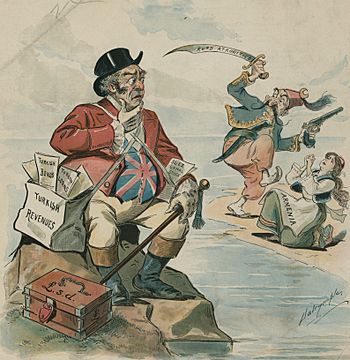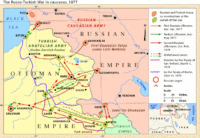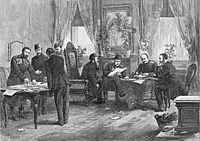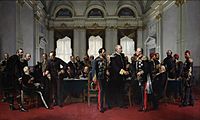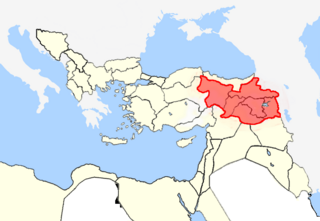Armenian question facts for kids
The Armenian question was a big discussion that started after the Congress of Berlin in 1878. It was all about how the Armenians in the Ottoman Empire should be treated. This term became very common among diplomats and in the news.
Basically, the Armenian question was about protecting Armenians and giving them freedoms from their neighbors. It covers 40 years of history between Armenians and the Ottoman Empire, looking at how countries like England, Germany, and Russia were involved from 1877 to 1914. Sadly, in 1915, the leaders of the Committee of Union and Progress, who ran the Ottoman government, decided to end the Armenian question by removing most Armenians from the empire. This terrible event is known as the Armenian genocide.
Contents
How It Started
In the mid-1800s, powerful countries like Britain, France, and Russia (called the Great Powers) started to worry about how the Ottoman Empire treated its Christian people. They pushed the Ottoman Empire to give equal rights to all its citizens.
After Christian groups in places like Bosnia and Herzegovina, Bulgaria, and Serbia faced violence in 1875, the Great Powers used the 1856 Treaty of Paris as a reason to step in and protect Christians in the Ottoman Empire.
By the late 1870s, the Greeks and other Christian groups in the Balkans were unhappy with their situation. With help from the Great Powers, they broke free from Ottoman rule. However, the Armenians didn't get as much attention or lasting support from these powerful countries. Their situation didn't change much. They were even called millet-i sadıka, meaning the "loyal community" in the Ottoman Empire.
In 1827–28, Tsar Nicholas I of Russia asked for help from Persian Armenians during the Russo-Persian War. He promised to help them afterward. In 1828, Russia declared war on Turkey. Russia then took over areas like the Erivan Khanate and Nakhichevan Khanate through the Treaty of Turkmenchay. After this treaty, Armenians still living under Persian rule were encouraged to move to Russian Armenia, and about 30,000 did.
Russia gained control over a large part of Armenia and became a strong supporter of Armenians in the Ottoman Empire. Many Armenians were drawn to Russia, getting educated and adopting Russian customs. Russia also became a way for Armenians to connect with Europe. By the 1897 Russian Census, over 1.1 million Armenians lived in Russian lands. Around the same time (1896), about 1.1 million Armenians lived in the Ottoman Empire. As Russia expanded its southern border, it became more involved in Ottoman affairs. Russia played a key role in helping Romania and Serbia become independent.
The Issue Becomes International
Most Armenians lived in provinces of the Ottoman Empire that bordered Russia. Through the Treaty of Adrianople, the Ottoman Empire gave Akhalkalak and Akhaltsikhe to Russia. About 25,000 Ottoman Armenians moved to Russian Armenia. Because of this, Armenians started to see the Russian Empire as the main country that could keep them safe.
Many Armenians in the eastern parts of the Ottoman Empire faced violence and theft from neighboring groups. They saw the advancing Russian army as helpers. In January 1878, the Armenian Patriarch of Constantinople, Nerses II Varzhapetian, asked Russian leaders to make sure the new peace treaty would include rules for Armenians to manage their own affairs.
In March 1878, after the Russo-Turkish War (1877–1878) ended, Patriarch Nerses Varzhapetian told the Great Powers about many Armenian complaints. These included "forced land seizure... forced conversion of women and children, arson, protection racket, and murder." Patriarch Nerses Varzhapetian convinced the Russians to add Article 16 to the Treaty of San Stefano. This article said that Russian troops would only leave the Armenian-populated areas in the eastern Ottoman Empire after reforms were fully put in place.
Article 16 of the Treaty of San Stefano stated:
As the evacuation of the Russian troops of the territory they occupy in Armenia, and which is to be restored to Turkey, might give rise to conflicts and complications detrimental to the maintenance of good relations between the two countries, the Sublime Porte engaged to carry into effect, without further delay, the improvements and reforms demanded by local requirements in the provinces inhabited by Armenians and to guarantee their security from Kurds and Circassians.
However, in June 1878, Great Britain didn't like Russia keeping so much Ottoman land. They pushed for the great powers to have new talks at the Congress of Berlin. Article 16 was changed, and any mention of Russian forces staying in the provinces was removed. Instead, the Ottoman government was supposed to regularly tell the Great Powers about the progress of the reforms. In the final Treaty of Berlin, this became Article 61, which said:
The Sublime Porte undertakes to carry out, without further delay, the improvements and reforms demanded by local requirements in the provinces inhabited by Armenians, and to guarantee their security against the Circassians and Kurds. It will periodically make known the steps taken to this effect to the powers, who will superintend their application.
The Armenian National Assembly and Patriarch Nerses Varzhapetian asked Mkrtich Khrimian, who was a former Patriarch and would become a future Catholicos, to speak for the Armenians in Berlin. An Armenian group led by Mkrtich Khrimian went to Berlin, but they were not allowed to join the talks. After the Berlin negotiations, Mkrtich Khrimian gave a famous speech called “The Paper Ladle.” He told Armenians to look at how Bulgaria gained its independence as a guide for their own hopes for self-determination. In Bulgarian history, the Liberation of Bulgaria refers to the events of the Russo-Turkish War of 1877–78 that led to Bulgaria becoming an independent state with the Treaty of San Stefano.
In 1880, Armenians, especially encouraged by British Prime Minister Gladstone, brought up the Armenian issue again. Gladstone said, "To serve Armenia is to serve Civilization." On June 11, 1880, the Great Powers sent a note called an "Identic Note" to the Ottoman government, asking them to put Article 61 into action. This was followed on January 2, 1881, by a "British Circular on Armenia" sent to the other Powers.
Armenian Reform Plans
The Armenian reform program of May 11, 1895, was a set of changes suggested by European Powers. French diplomat Victor Bérard wrote:
After six months of constant massacres, while Europe pretended that the Armenian Question was already solved, the Armenians decided to show Europe that the Armenian Question still existed but that there was no Ottoman government any more.
1914 Armenian Reforms
The 1914 Armenian reforms were plans made by European powers between 1912 and 1914. They suggested creating two provinces in the Ottoman Empire that would be watched over by two European inspectors. However, these reforms were never actually put into place.
Because there wasn't much progress in helping the Armenian community, some Armenian thinkers living in Europe and Russia in the 1880s and 1890s became very disappointed. They decided to form political parties and groups to work towards better conditions for their people.
Images for kids
See also
 In Spanish: Cuestión armenia para niños
In Spanish: Cuestión armenia para niños
- Armenia without Armenians


